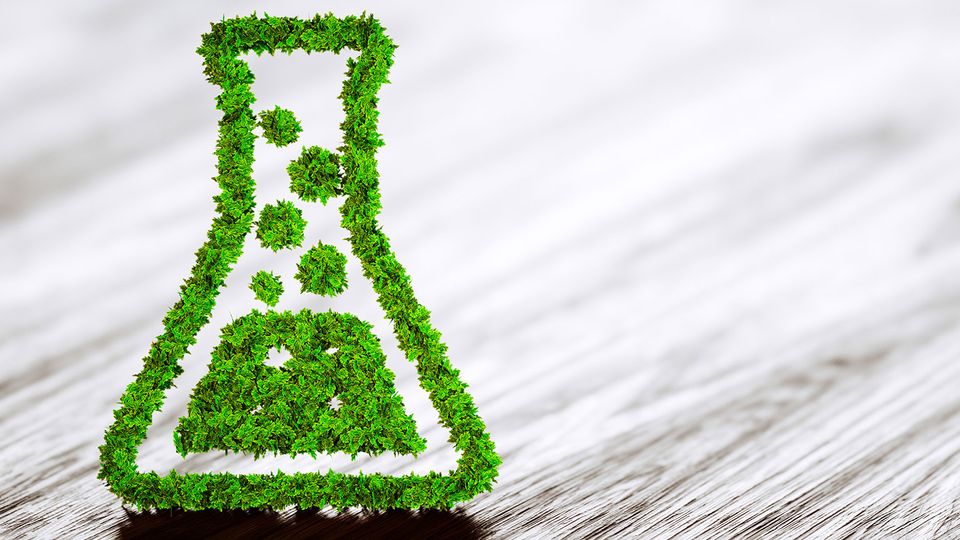Lab Sustainability: A Holistic Approach
Listicle
Published: June 19, 2023
|
Srividya Kailasam, PhD
Srividya Kailasam holds a PhD in analytical chemistry from the Indian Institute of Technology, Madras. She has developed numerous LC, LC-MS and LC-MS/MS methods for the analysis of a variety of samples.
Learn about our editorial policies

Credit: iStock
Due to the diverse nature of labs, the need for heating and cooling, and the presence of energy-intensive instruments, it is hardly surprising that labs consume inordinate amounts of resources and generate large volumes of waste.
In the past few years, there has been an increasing awareness of the environmental footprint of labs and a growing trend toward “sustainable laboratories”. The scientific community has started to focus on areas that make labs sustainable.
Download this listicle to learn more about:
- Optimal lab design
- Environmentally friendly equipment and instrumentation
- Training and adoption of sustainable practices
Listicle
1
Lab Sustainability: A Holistic Approach
Srividya Kailasam, PhD
Laboratories are complex spaces that cater to different disciplines and are designed to carry out
activities ranging from wet chemical reactions and microbiological studies to analysis using sophisticated
instruments. They may be operated as independent commercial establishments (e.g., testing labs), or
they could be part of educational or research institutions, companies and hospitals. Given this diversity,
the need for heating and cooling, and the presence of energy-intensive instruments, it is hardly surprising
that labs consume inordinate amounts of resources and generate large volumes of waste. These could be
both solid and liquid and possibly infectious.
In the past few years, there has been an increasing awareness of the environmental footprint of labs
and a growing trend toward “sustainable laboratories”.1
The scientific community has started to focus
on areas that make labs sustainable. In a study published in 2022, My Green Lab and Intercontinental
Exchange Inc. (ICE), identified that many pharma and biotech companies have adopted zero carbon goals.
In this listicle, we explore how a holistic approach that includes optimal lab design, environmentally
friendly equipment and instrumentation, and awareness about the impact of labs, coupled with training
and adoption of sustainable practices, is required to make labs “green”.
Lab design
A laboratory’s design can have a vast impact on its sustainability. Careful consideration when building,
setting up or renovating a laboratory can help to reduce wastage and lead to improved energy efficiency.
A lab should be designed to increase the amount of natural lighting and energy-efficient artificial
lighting should be used as a supplement to the daylight. Increasing natural lighting is known to not only
improve productivity, but also save costs. A white or nearly white ceiling is recommended for the proper
distribution of natural lighting. Dark bench tops and reagent shelves that make the room seem darker
must be avoided.
While a well-lit, air-conditioned lab is essential for the proper running of sophisticated instruments, it
is important to turn off the lights and air conditioning when the instruments are not in use. To ensure
compliance, team members can take turns switching off the lights and equipment not in use. Regular
light bulbs can be replaced with LED bulbs. Temperature control can also be achieved using chilled
beams.
When designing a sustainable lab, factors such as its size, layout and infrastructure flexibility must be
borne in mind to minimize energy consumption and adapt to future technological changes. The use of
modular and reconfigurable furniture also helps in creating a sustainable lab.
LAB SUSTAINABILITY: A HOLISTIC APPROACH 2
Listicle
Biosafety labs must ensure unidirectional flow of materials and personnel and incorporate controls
such as negative pressure zones and airtight doors and windows to prevent highly infectious pathogens
from escaping into surrounding areas. Since all materials entering a biosafety level 3 lab (BSL3) are
considered biohazardous, minimizing the materials (paper, media bottles, plastics, etc.) brought into
biosafety labs will reduce the necessity to autoclave and/or dispose of these materials that could
otherwise be reused.
Several resources are available to help with planning the creation of a sustainable lab. For example,
a strategic design framework, Green Lab, has been developed to help create labs with minimal
environmental impact using recycled materials. These labs should be capable of generating energy from
renewable sources.2
Involving a wide range of stakeholders, applying the highest possible sustainability standards and
balancing lab sustainability goals with the health and safety of personnel are suggested as the three keys
to designing a sustainable lab.3
Equipment
Labs depend on a huge variety of equipment, and careful consideration during its purchase, use and
disposal is crucial in ensuring sustainability goals are met.
When upgrading or replacing existing instruments, certified environmentally friendly options, such as
those with ENERGY STAR® and ACT (Accountability, Consistency and Transparency) labels, should be
purchased. The Environmental Impact Factor (EIF) criteria form the basis of creating the labels for life
science products. These labels provide scores for parameters such as renewable energy used during
manufacture, water consumed during use and sustainability impact at the end-of-life stage. Lower overall
score indicates lesser overall environmental impact. In addition, My Green Lab certification helps the labs
get their sustainability practices audited.
Choosing models that consume fewer resources, including energy and solvents, helps to reduce the
environmental impact. For instance, smaller autoclaves with more efficient vacuum generation systems
consume less water and can be used instead of a larger model.
Periodic maintenance of all lab equipment and instruments must be carried out to ensure optimal
performance and energy efficiency. Keeping incubators, freezers, refrigerators and cold rooms clean and
frost-free will make them more energy efficient and will increase the lifespan of these products.
When possible, refurbished instruments can be used to minimize the build-up of hazardous substances
and other products that cannot be recycled in the environment. Manufacturers are increasingly investing
in building a circular economy for their instruments, offering incentives for labs to return their old
equipment, which can be refurbished and sold on.
Operation
Laboratories can contain a wide range of energy-intensive equipment that often requires continuous
operation. Subsequently, compared to office buildings, they typically consume 5 to 10 times more energy
per square foot. Coupled with this, many processes depend on single-use plastics and use vast amounts
of water. Although it is challenging for laboratories to try to match the resource consumption and waste
output of a space with such different needs, several steps can be taken to improve their operational
efficiency.
LAB SUSTAINABILITY: A HOLISTIC APPROACH 3
Listicle
Instruments such as chromatographs, mass spectrometers and spectroscopes can be shut down when
not in use. Similarly, other equipment such as pH meters, balances, centrifuges and water baths can
also be turned off when not in use. Equipment that doesn’t require continuous use can be fitted with
programmable outlet timers, which could help to reduce equipment energy consumption by up to 50%.
When in use, the sash of fume hoods should be kept in the lowest possible position to improve exhaust
efficiency and thus save energy. Energy can also be saved by lowering the airflow volume when the fume
hoods are not in use. When possible, ductless hoods that filter contaminated air before recirculating it can
be used. Operating ultra-low temperature freezers at -70 °C instead of -80 °C saves energy without being
detrimental to the samples.
Labs should reduce, recycle and reuse plastic products whenever possible. Consolidating orders for
plastic ware, glassware and chemicals for the different projects/experiments running in the lab or for
multiple labs, buying smaller pack sizes or buying just pipette tips instead of boxed tips can reduce the
plastic waste in the lab.
Routine lab activities such as filtration, which is an integral part of sample preparation, generates plastic
waste such as single-use syringes and filter cartridges. These and other plastic wastes, such as pipette
tips, tip boxes, syringes, tubes and nitrile gloves, can be recycled instead of sending them to landfills or
incineration. When recycling, care should be taken to disinfect biowastes and segregate these along with
other hazardous wastes from recyclable, non-hazardous plastic wastes. A lab case report documented
various approaches, such as reusing decontaminated plastic tubes and using sustainable materials like
reusable wooden sticks for patch plating and metal loops for inoculation that helped reduce and reuse
single-use plastics in a microbiology lab. After implementing these strategies, the lab demonstrated a 43
Kg reduction in plastic waste in 4 weeks, in addition to reducing costs.4A report from MIT demonstrates
the feasibility of recycling clean lab plastics, stating that the Environmental Health and Safety (EHS) office
collected nearly 280 pounds of plastic waste from participating labs every week in 2022 for recycling.
To minimize water consumption, taps and other water outlets can be fitted with spray nozzles or lowflow aerators, and recirculating water baths used for cooling reactions that can be carried out on a
smaller scale. To reduce water wastage, leakage from faucets, autoclaves, water baths and any seepage
from water pipes should be attended to as soon as possible. Washing and autoclaving should be done
with minimal wastage of water. Scientists, students and lab personnel should cooperate to ensure that
autoclaves are run at full capacity to reduce water as well as energy consumption.
Less hazardous substitutes for chemicals and cleaning supplies should be used whenever possible.
Labs and workspaces must be kept clean to prevent cross-contamination that leads to wastage. Simple
actions like proper labeling and storage of chemicals will enhance their shelf-life and proper usage.
Experiments should be designed to derive maximum information with minimum consumption of
resources as well as minimum waste generation. This will also reduce the number of experiments and
eliminate erroneous experiments. Replacing paper-based lab notebooks, operating procedures and test
protocols with electronic records will help minimize paper consumption. Computers and other office
equipment can be turned off when not in use.
Training
Educating stakeholders on the importance of sustainability is a crucial requirement for achieving a green
laboratory. In addition to training the scientists on guidelines and regulations, they must be sensitized
towards the ecological impact of indiscriminate usage of chemicals, glassware, plastic ware and
consumption of resources, especially electricity and consequent generation of waste in the laboratories.
LAB SUSTAINABILITY: A HOLISTIC APPROACH 4
Listicle
The importance of education and capacity building in “green chemistry” and “sustainable chemistry”
for creating greener and more sustainable processes has been described by Zuin et al.5 Sustainability
in Quality Improvement (SusQI), developed by The Centre for Sustainable Healthcare (CSH) adopts
principles of Education for Sustainable Development (ESD) such as “future thinking” and “systems
thinking” and “thinking creatively” in the training programs for clinical laboratory professionals.6
Several resources are available online for learning and disseminating information regarding lab
sustainability. LEAF or Laboratory Efficiency Assessment Framework, an independent standard for
good environmental practice in labs designed by University College London, provides training, a toolkit,
resources and strategies for improving the sustainability and efficiency of labs.
Behavior
As behavioral changes take time, training on lab sustainability must be augmented with monitoring,
reminders and encouragement to implement practices that will lead to smaller carbon footprints.
Educational institutions have started initiatives such as “Unplug” and “Shut the Sash” competitions to
encourage lab users to adopt energy-saving practices. In the “Sustainable Laboratories” report published
by the Royal Society of Chemistry, recognizing and rewarding initiatives and actions that promote
sustainability in the labs has been listed as the first plan of action along with providing resources, funds
and advocating for change.
Leaders can make a difference by setting the right goals and performance indicators on sustainability,
encouraging collaboration and, most importantly, walking the talk. The “Green Labs Guide” published by
the University of Pennsylvania and sustainable research practices on Princeton University’s EHS website
provide a number of strategies and checklists that can help lab managers to make their labs sustainable.
Conclusion
Sustainability in a lab should become a way of life. It will not only reduce the environmental impact, but
also save money in the longer term, offsetting the initial investments for achieving sustainability. A “green
lab” should be the collective responsibility of all the team members. A well designed and well maintained
lab also contributes to higher efficiency and productivity. Awareness and taking simple steps can go a
long way in improving lab sustainability.
Sponsored by:
References
1. Durgan J, Rodríguez-Martínez M and Rouse B. Green labs: a guide to developing sustainable science in your organization.
Immunol Cell Biol. 2023;101: 289-301. doi: 10.1111/imcb.12624
2. Belibani R, Gigliarelli E, Patterson J. Green lab: a strategic design framework to develop sustainable research
laboratories. In: Dincer, I., Midilli, A., Kucuk, H. (eds) Progress in Sustainable Energy Technologies Vol II. Springer, Cham.
(2014). doi: 10.1007/978-3-319-07977-6_18
3. Erica Hersh. Three keys to sustainable lab design to improve health and safety. Harvard School of Public Health. https://
www.hsph.harvard.edu/ecpe/three-keys-sustainable-lab-design-improve-health-safety/. Published March 29, 2019.
LAB SUSTAINABILITY: A HOLISTIC APPROACH 5
Listicle
Accessed June 07, 2023.
4. Alves J, Sargison FA, Stawarz H, et al. A case report: insights into reducing plastic waste in a microbiology
laboratory. Access Microbiol. 2021;3:000173. doi: 10.1099/acmi.0.000173
5. Zuin V, Eilks I, Elschami M, Kümmerer K. Education in green chemistry and in sustainable chemistry: perspectives
towards sustainability. Green Chem. 2021;23:1594-1608. doi: 10.1039/D0GC03313H
6. Scott S. Embedding education into clinical laboratory professional training to foster sustainable development and
greener practice. Clin Chem Lab Med. 2023;61(4): pp. 638-641. doi: 10.1515/cclm-2022-1152
Sponsored by

Download the List for FREE Now!
Information you provide will be shared with the sponsors for this content. Technology Networks or its sponsors may contact you to offer you content or products based on your interest in this topic. You may opt-out at any time.


